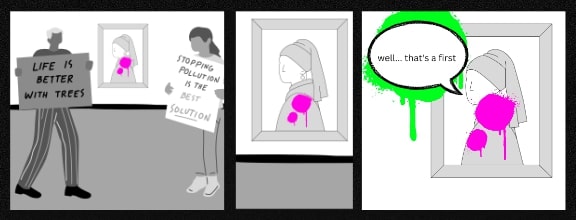Climate activists seek unexpected outlets to convey their urgent message

With soup on paintings and other eco-vandalism actions, the climate change gambit is changing.
January 24, 2023
Eco-vandalism is on the rise after two students, Phoebe Plummer and Anna Holland, tossed soup on “Sunflowers”, a painting by Vincent Van Gogh, to protest against the use of fossil fuels in October 2022.
Confrontational activism, which eco-vandalism falls under, draws from emotions, especially anger, frustration, passion, and fear, in order to address authority. It emphasizes the necessity and importance for change for impending disastrous issues like climate change.
Young people are taking the matter of climate change into their own hands, angry at the inaction and inefficiency demonstrated by the government’s actions to tackle climate change.
“83% of [young adults surveyed in 10 countries] said they think people have failed to take care of the planet, ” according to a journal article from The Lancet Health.
Young people have felt as though what was promised to them has been undelivered and so have taken it upon themselves to demonstrate the importance of the climate change problem.
“These activists may feel as if words have failed them and the movement thus far and want to intensify the way the message is conveyed, ” according to psychologist Renee Lertzman, who is also the founder of Project InsideOut (a climate activism platform).
More than ever, eco-vandalism has become more prominent in the media. In October, a pair of young activists protested the harvest and processing of oil by British companies and threw soup at Vincent Van Gogh’s painting “Sunflowers” in London. This isn’t an isolated event as other news has included a mashed potato being flung at Monet’s painting in Germany and climate activists sticking their hands on the “Girl with a Pearl Earring” in the Netherlands, both in October. Though there were a variety of different ways climate change activists used paintings, they all were for the singular reason to bring awareness and attention to the issue of climate change.
The activists responsible for these demonstrations have come from a variety of different organizations tackling climate change. From Ultima Generazione, accountable for events at Florence, and Letzte Generation, responsible for the stunt with the Monet Painting, different activists from eco-vandalism and environmental protest organizations like Just Stop Oil are continuing to use this shock-factor method for awareness. Just Stop Oil members hold the most number of paintings vandalized, which include the Van Gogh painting and, more recently, The Girl With The Pearl Earring Painting.
Just Stop Oil’s main purpose as an organization is to abolish the US government’s right to create new licenses and consents for the production of fossil fuels. Their main morals towards climate activism is to participate in non-violent, civil disobedience protests. Most of their funding, which comes from the Climate Emergency Fund, is to ensure the continuation of climate activism.
The extravagant efforts made by climate change activists involved in eco-vandalism have spread through the media and have been circulated around the globe. Their intention to become more commonly used and provide a shock factor has worked through multiple news outlets covering these stories and the purpose. Though there is much debate on the ethical aspect of the practice, the actual outcome of the protest is foggy. Instead of the discussion on climate change it had been skewed towards the actions of the activist. There isn’t much further action taken on what activists have been fighting for and it seems that their efforts have fallen under a media grab plot.


